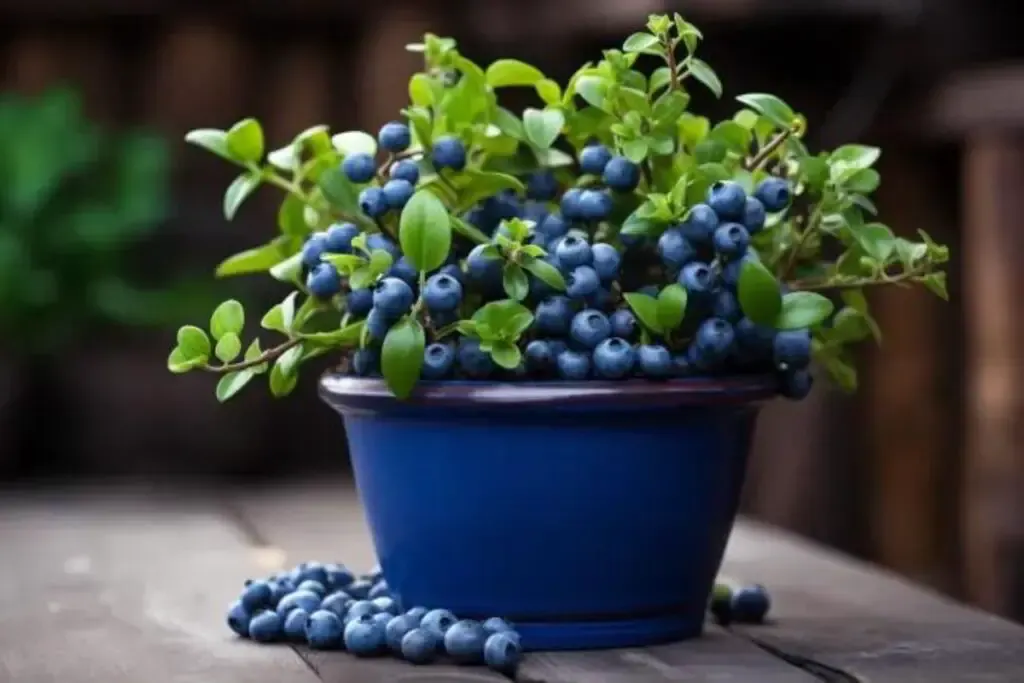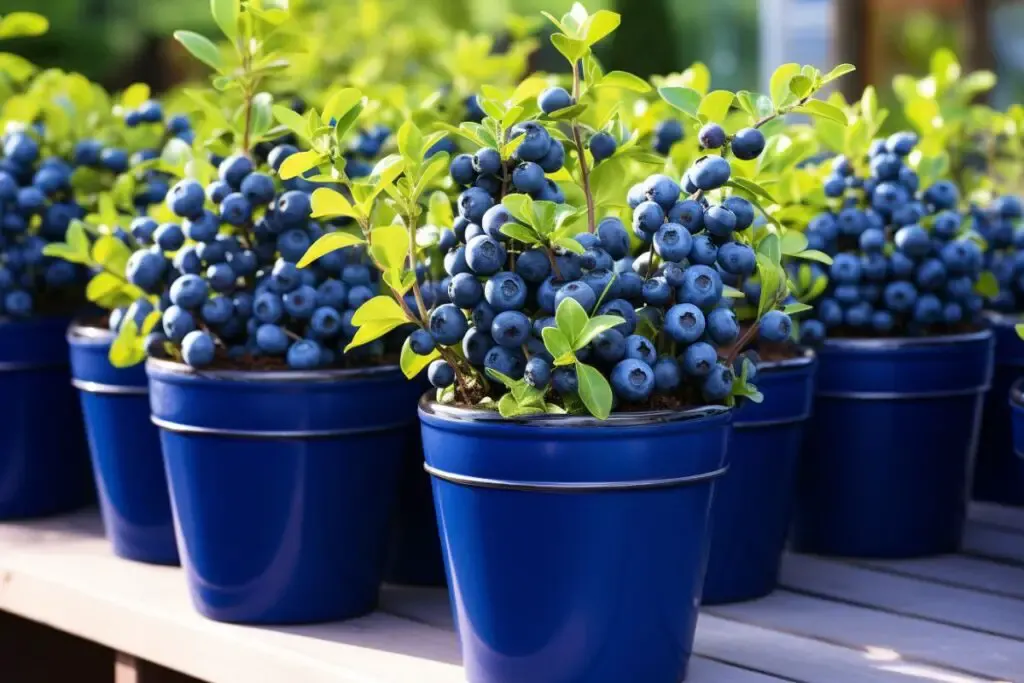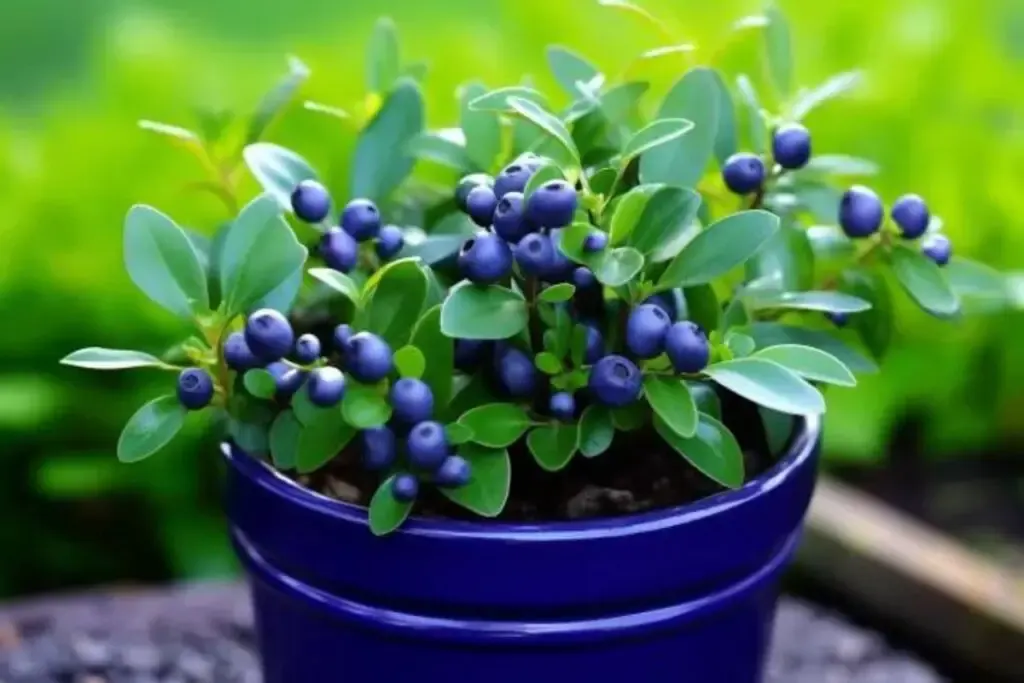Growing blueberries in pots is a delightful experience that combines the joys of gardening with the sweet reward of fresh, sun-ripened berries.
Whether you have a sprawling backyard or a small balcony space, blueberries are versatile fruits that adapt well to container living. Plus, there’s nothing quite like the taste of a blueberry picked straight from your own plant.
As a seasoned gardener with a penchant for potting, I’ll guide you through the process of nurturing these blue gems to perfection.
Do Blueberries Grow Well in Pots?
The simple answer is a resounding yes! Blueberries can thrive in pots as they have a relatively shallow root system, which makes them ideal for container gardening. However, the key to success lies in the choice of container, the soil composition, and ensuring they receive the right amount of TLC.
When potted, blueberries offer the advantage of soil control; you can give them the exact soil acidity they crave. They also appreciate the drainage provided by pots, as waterlogged roots are a common pitfall in garden soil.
Moreover, pots make it easy to protect your blueberries from birds and pests, and you can move them around to chase the sun—a blueberry’s best friend! Growing blueberries in containers also allows those in cooler climates to overwinter the plants indoors or in a sheltered area, ensuring the survival of your plants year after year. It’s a win-win!
Best Blueberry Varieties for Pots
Not all blueberries are created equal, especially when it comes to potting. Let’s look at some varieties that are particularly well-suited to life in containers.
1. Top Hat Blueberry

The ‘Top Hat’ blueberry is a compact variety that is perfect for small spaces. As a dwarf cultivar, it won’t grow taller than 24 inches, making it ideal for a cozy patio or balcony.
Don’t let its size fool you, though—this little bush packs a punch with its bountiful harvest. It’s a self-pollinating plant, which means you don’t necessarily need another bush for cross-pollination. Plus, it’s as ornamental as it is tasty, with stunning white blossoms in spring and fiery red foliage in the fall.
2. Sunshine Blue Blueberry

‘Sunshine Blue’ is another variety that’s well-suited for containers due to its semi-dwarf stature. It typically grows to about 3-4 feet in height and offers a generous mid to late-season harvest.
What sets ‘Sunshine Blue’ apart is its tolerance to higher pH soils, making it a bit more forgiving for the beginner gardener. Its vibrant pink flowers are not only a visual treat but also attract pollinators to your garden space.
3. Jelly Bean Blueberry

The ‘Jelly Bean’ is a newer variety on the blueberry scene and has been specifically bred for pot culture. This bush is incredibly hardy and has been known to withstand some pretty tough conditions.
With its plump, flavorful berries and a mature height of just 1-2 feet, ‘Jelly Bean’ is an excellent choice for those looking to save on space. It’s also particularly cold-hardy, which is great for gardeners in chillier zones.
How to Grow and Care For Blueberries in Pots
The journey to grow blueberries in pots can be as rewarding as it is decorative. With the right care, these berries will not only produce delectable fruits but also add a splash of color to your garden space with their vibrant foliage and blossoms.
Let’s walk through the essentials of planting and caring for your potted blueberry plants.
Planting
Planting blueberries in pots is best done in late winter or early spring. Select a high-quality potting mix designed for acid-loving plants and ensure the pot has adequate drainage holes.
Plant the blueberry bush at the same depth it was grown in the nursery pot, and gently firm the soil around it without compacting it too much. This ensures that the roots have the perfect balance of support and space to spread.
Pot Size
Blueberries don’t have deep root systems, but they do need space to spread out. A pot that’s at least 18-24 inches in diameter and a similar depth is a good start.
This size will accommodate the plant’s growth for several years before it might need a larger home. Remember, too small a pot will restrict growth, while too large a pot can lead to waterlogging.
Light
Light plays a pivotal role in the successful cultivation of blueberries in pots. These delightful berry bushes require full sun to produce the best fruit. Aim for at least 6-8 hours of direct sunlight each day.
In my own container garden, I position my blueberry pots in the sunniest spot available. If you live in a region with extremely hot summers, a little afternoon shade can be beneficial to prevent overheating.
It’s important to remember that adequate sunlight not only boosts berry production but also contributes to the overall health of the plant, resulting in vibrant foliage and stronger growth. So, finding that sunny spot in your garden, balcony, or patio is essential for a fruitful blueberry harvest.
Soil
Selecting the right soil is key for thriving blueberry plants in pots. They require acidic soil with a pH between 4.5 and 5.5. Opt for a specialized potting mix for acid-loving plants, ensuring it provides good drainage while retaining sufficient moisture.
Incorporating sphagnum peat moss or pine bark can help maintain the necessary acidity and soil structure. Regular pH testing and adjustments are crucial for the health and productivity of your blueberries.
Water
Consistent moisture is key for blueberries, but they don’t like “wet feet.” Ensure you’re providing regular watering while allowing the top inch of soil to dry out between waterings.
During hot spells, you might need to water more frequently. Always water thoroughly until it runs out of the drainage holes, but never let the pots sit in water, as this can lead to root rot.
Temperature and Humidity
Blueberries are quite adaptable, but they do have their preferences. They like it “just right” — not too hot and not too cold.
A temperate climate is ideal, but with careful placement and possible relocation during extreme temperatures, blueberries can adjust. They don’t require high humidity but can tolerate it as long as they have good air circulation.
Fertilizer
Feed your blueberries with a fertilizer formulated for acid-loving plants, typically one that’s high in nitrogen. However, be careful not to over-fertilize; following the recommendations on the fertilizer package is crucial.
Slow-release fertilizers are ideal, as they feed your plants over time. Fertilizing should be done in the early spring and again in late spring for the best results.
Pruning Potted Blueberries
Pruning is a vital part of keeping your blueberry plants healthy and productive, especially when they’re confined to a pot. As a rule of thumb, you don’t need to prune blueberry plants for the first three years.
After that, pruning becomes an annual task that you should carry out in late winter or early spring before new growth appears. Focus on removing any dead or diseased branches first. Then, thin out the branches to ensure that light and air can penetrate the canopy of the plant—this promotes healthy growth and reduces the risks of disease.
You should also remove any branches that are crossing over others to prevent damage and open up the plant’s structure. Cut back about a third of the oldest, woodiest stems almost to the base to encourage new, more vigorous growth.
This practice also helps maintain an ideal balance between shoot growth and fruit production. Remember to make clean cuts with a sharp pair of pruning shears, as ragged cuts can be more vulnerable to disease.
Overwintering
Blueberries are hardy plants, but they do need some protection during the winter, particularly when grown in pots, as their roots are more exposed to the elements than those in the ground. When temperatures start to drop, here’s how you can protect your potted blueberries:
- Insulation: Wrap the pot with bubble wrap, burlap, or horticultural fleece to insulate the roots from freezing temperatures.
- Location: Move the pots against a house wall or into a sheltered spot to protect them from harsh winds. If you live in an area with very severe winters, consider moving the pots into an unheated garage or shed.
- Watering: Keep the soil slightly moist but not wet. Check the moisture level occasionally, as the roots can still be active, and use water on warmer days.
- Mulching: Apply a thick layer of mulch over the soil surface to provide additional insulation. Pine needles, straws, or bark chips can serve as good mulch materials.
- Pruning: Don’t prune your plants in the fall. Waiting until late winter allows any dead wood from frost damage to become evident and can then be removed.
Come spring, gradually reintroduce your blueberry plants to more light and warmer conditions to wake them up for the new growing season. With these protections in place, your blueberries should emerge from their winter dormancy healthy and ready to grow.

